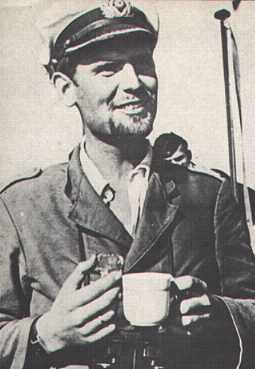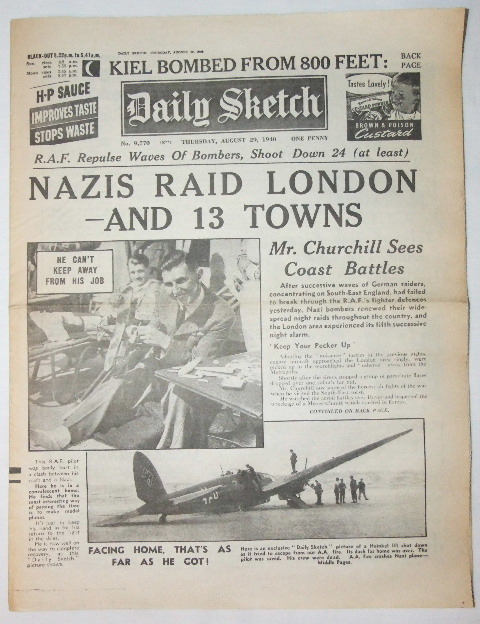Wednesday 29 August 1940
 |
| Kapitänleutnant Joachim Schepke. |
On the 28th, the RAF had swallowed the bait and sent fighters up to attack Bf 109s on "Freie Jagds" (attacks without bombers). Perhaps to see if the same will happen again, they send very few bombers during daylight hours. Since the British refuse to engage only fighters, the only planes flying over England for much of the afternoon are Luftwaffe fighters looking for targets to strafe. There are literally hundreds of them, but they have little to do.
Around 15:00, large formations of German aircraft head for Dover. They split off and attack RAF fields at Tangmere and Biggin Hill. These are massive fighter sweeps of Bf 109Es which strafe but can do little damage to infrastructure. The RAF barely deigns to notice these sweeps, as they are more interested in defending against the bombers and not frittering away strength in dogfights.
About an hour later, a smaller force attacks the Scilly Isles.
At 17:25, a group of about 20 aircraft heads for Rochester.
At dusk, the Luftwaffe sends raids against Debden and Duxford airfields.
During the night, Liverpool is attacked. There is some damage to flats and electrical/water works, but manageable. The British try a new tactic of setting decoy fires in the countryside to attract bombers thinking that it is a blazing city, and some of the bombers fall for it. These are called "Starfish sites."
The Luftwaffe damages British freighter Baltistan.
RAF Bomber Command raids various targets along the Channel coast and in the Ruhr. Oil installations remain at the top of the list.
Losses for the day are usually put at around 17 for the Luftwaffe and 10 for the RAF. Some accounts state that the Luftwaffe actually won the day or at least tied in terms of fighter losses, which, if true, is a rarity.
The decision by the RAF - primarily by Vice Air Marshal Keith Park at No. 11 Group - not to contest the Luftwaffe's fighter sweeps results in the erroneous conclusion within the Luftwaffe that they have won the Battle of Britain.
RAF No. 305 (Polish) forms at Bramcote, Nuneaton. RAF Fighter Command decides to fob its Bolton Paul Defiants, which have been death traps for their pilots, off on the Poles of No. 307 Squadron.
 |
| U-100. |
Schepke waits until dark, then surfaces in the middle of the convoy. He first fires two torpedoes. One of the torpedoes hits 4608-ton British freighter Dalblair, with the torpedo hitting amidships on the starboard side. It sinks within 10 minutes. There are 18 survivors and 24 men perish (figures are for the end of the night). Some of the survivors are picked up by the Swedish freighter Alida Gorthon, others by Royal Navy escort destroyer HMS Clematis.
The other torpedo hits British freighter Hartismere. It is only damaged and makes it to port.
U-100 then stalks another ship, the 2393 ton Astra II. Just as Schepke is about to fire, the ship drastically alters course and almost rams the U-boat. Schepke evades with difficulty, then uses his stern tubes to put a torpedo into it. The Astra II sinks with 20 survivors and 5 deaths.
U-100 then torpedoes and sinks small 2373 ton Swedish freighter Alida Gorthon. The freighter previously picked up 24 survivors from the SS Dalblair. Among the people on board, there are 11 deaths and 13 survivors from the Alida Gorthon's own crew, and 4 survivors and 20 deaths from the survivors of the Dalblair.
The convoy has been ordered to scatter (a planned maneuver when under threat). Schepke has targets of opportunity all around him but is almost out of torpedoes. Schepke puts his last torpedo into large 6103 ton British freighter Empire Moose, which sinks within 15 minutes. Everybody aboard survives.
Schepke's score for the night is four ships sunk and another damaged. Now out of torpedoes, he evades the escorts and heads for U-100's new homeport of Lorient, France.
Convoys OA 206 and MT 154 depart from Methil, Convoy OB 205 departs from Liverpool, Convoy FN 266 departs from Southend, Convoy FS 266 departs from the Tyne.
Battle of the Mediterranean: The Italians send a large force of bombers and escorting CR 42 biplane fighters (a dozen of each) against Malta at 08:37. Defending Hurricane fighters scramble and a dogfight begins. The bombers damage numerous buildings with 30 high explosive bombs and cause 6 civilian casualties. Neither side loses any planes.
A large convoy (MF 2) with supplies for Malta sails from Alexandria. As a diversion, some Royal Navy assets (Force F) at Gibraltar will head east toward Alexandria (Operation Hats). This is a major fleet operation in two directions at once led by battleships Malaya and Warspite and aircraft carrier Eagle.
The South African Air Force conducts raids against Italian positions in Somaliland and Mogadishu. The Italians bomb Matruh with 30 bombers.
 |
| A British 9.2-inch coastal defense gun crew watch an RAF Coastal Command Short Sunderland flying boat passing overhead, 29 August 1940. |
Applied Technology: British scientists of the so-called Tizard Mission, named for scientist Sir Henry Tizard, board a liner with the so-called "secret box" of advanced scientific instruments. They are bound for the United States, where Sir Henry is waiting for them. Their most significant item is a prototype cavity magnetron, which is a leap forward in radar technology. Other items include blueprints and circuit diagrams for rockets, explosives, superchargers, gyroscopic gunsights, submarine detection devices, self-sealing fuel tanks, and information relating to the development of the jet engine and the atomic bomb.
Anglo/German Relations: In a rare bit of attempted cross-Channel diplomacy during the Battle of Britain, Germany proposes to the British that Red Cross ships be used to recover downed Luftwaffe airmen in the Channel. The British, who have been shooting down the Luftwaffe's Heinkel seaplanes used for this purpose, refuse.
German/Irish Relations: In a rare act of contrition during the conflict, Germany formally apologizes to Ireland for bombing Wexford a couple of days previously.
German/Italian/Hungarian/Romanian Relations: The foreign ministers from each country meet in Vienna to reach an accommodation regarding territorial claims in the region. Hungary desires pieces of Romanian territory, and both sides have been accusing the other of unlawful overflights. The outline of a plan develops in which northern Transylvania will be ceded by Romania to Hungary. This is the famous "Vienna Award."
Gabon: While Equatorial Africa and Cameroon have joined the Free French movement, Gabon is less certain. Governor Georges Pierre Masson first offers his support, but then retracts it under pressure from the French naval commander at Gabon, who sides with the Vichy government.
US Military: The new commander of the US Navy Ninth Naval District and the US Naval Training Center in the Great Lakes is Rear Admiral John Downes. This is where many naval aviators are trained on a special paddle-wheel aircraft carrier.
The first mass paratroop jump in US Army history - following on some previous "experimental" jumps - takes place at Fort Benning, Georgia. US land air forces are organized at this time as the US Army Air Corps or USAAC.
Cruisers USS Quincy and Wichita make port in Buenos Aires as part of their "Show the flag" mission.
 |
| The Daily Sketch, 29 August 1940. |
Vichy France: The government forms the Legion Francais des Combattants, a government-sponsored organization for veterans.
Spain: The country remains neutral even if heavily leaning toward the Axis. Belgian Prime Minister Pierlot and Foreign Minister Spaak have taken refuge there, and today they attempt to reach London to form a government-in-exile.
Soviet Union: Kombrig Grigorii Fedorovich Kondrashov (various spellings), who had commanded the 18th Rifle Division during the Winter War, is executed. The charge is that he abandoned his division, which was encircled near Lemeti due to his negligence. Witnesses claimed that Kondrashov split his encircled force into two parts, then put all the best troops into his group and all the sick and wounded into the other group under someone else's command, and then broke through the lines with his picked men. Kondrashov himself supposedly changed into an ordinary soldier's uniform during the breakout. Ironically, the other group made it back intact, while Kondrashov's force was badly mauled. The division had been disbanded afterward, and Kondrashev arrested on 3 March 1940.
Future History: James Brady is born in Centralia, Illinois. He will become President Ronald Reagan's press secretary in the 1980s and be permanently disabled during the assassination attempt on Reagan's life. He later supported gun control, and the "Brady Bill" is named after him. Brady passed away on 4 August 2014.
 |
| A Whitley bomber pilot gives the 'thumbs up', 29 August 1940. |
August 1940
August 1, 1940: Two RN Subs Lost
August 2, 1940: Operation Hurry
August 3, 1940: Italians Attack British Somaliland
August 4, 1940: Dueling Legends in the US
August 5, 1940: First Plan for Barbarossa
August 6, 1940: Wipe Out The RAF
August 7, 1940: Burning Oil Plants
August 8, 1940: True Start of Battle of Britain
August 9, 1940: Aufbau Ost
August 10, 1940: Romania Clamps Down On Jews
August 11, 1940: Huge Aerial Losses
August 12, 1940: Attacks on Radar
August 13, 1940: Adler Tag
August 14, 1940: Sir Henry's Mission
August 15, 1940: Luftwaffe's Black Thursday
August 16, 1940: Wolfpack Time
August 17, 1940: Blockade of Britain
August 18, 1940: The Hardest Day
August 19, 1940: Enter The Zero
August 20, 1940: So Much Owed By So Many
August 21, 1940: Anglo Saxon Incident
August 22, 1940: Hellfire Corner
August 23, 1940: Seaplanes Attack
August 24, 1940: Slippery Slope
August 25, 1940: RAF Bombs Berlin
August 26, 1940: Troops Moved for Barbarossa
August 27, 1940: Air Base in Iceland
August 28, 1940: Call Me Meyer
August 29, 1940: Schepke's Big Day
August 30, 1940: RAF's Bad Day
August 31, 1940: Texel Disaster
2020
No comments:
Post a Comment